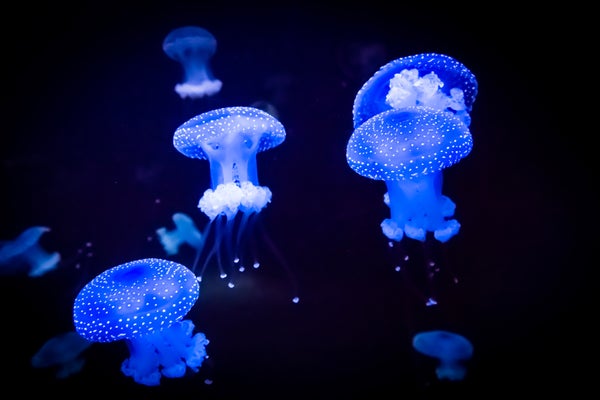Thousands of feet below the ocean’s surface, it’s pitch dark. Researchers sitting in a submersible turn off all the lights and, for a moment, even the whirring scrubber fans. In complete silence the humans stare out of a small fish bowl into a vast and mysterious deep sea—then the light show begins.
The majority of deep-sea organisms communicate via bioluminescence in order to attract mates, find food or warn off predators. As a result, the oceans are full of pulsing, propagating or diffusing blue and green light, emitted by creatures ranging from jellyfish to starfish to corals on the seafloor.
A study published last year by researchers at the Monterey Bay Aquarium Research Institute found around 76 percent of creatures observed off the California coast over 17 years displayed some kind of bioluminescence, and that’s only those that weren’t scared away by humans or underwater robots. “I think it’s the greatest light show in the world,” says Edith Widder, a marine biologist who founded the Ocean Research and Conservation Association andhas spent decades studying bioluminescent organisms through submersible dives. “It’s like being in the center of a silent fireworks display,” she says, “but the thing that makes it just absolutely breathtaking is that it’s living light.”
On supporting science journalism
If you're enjoying this article, consider supporting our award-winning journalism by subscribing. By purchasing a subscription you are helping to ensure the future of impactful stories about the discoveries and ideas shaping our world today.
The following video is part of Alucia Productions Powered By OceanX's and BBC Earth’s Our Blue Planet initiative, which is aimed at getting people talking about the ocean in all its beauty and complexity. “There’s been a lot of destruction done to the ocean, and a tremendous amount of it is just out of pure ignorance,” Widder says. “People don’t protect what they don’t love, and certainly not what they don’t even know.” Whether it’s the enormous nets dragged across the ocean floor to catch bottom-dwelling creatures, or the pesticides, oil and other pollution that trickles into the water, human activity is altering a complex and still-mysterious ecosystem.
Bottom trawling and other harmful practices “turn what are just absolutely exquisite undersea gardens that I’ve been able to see from submersibles that are filled with life…into a moonscape that won’t sustain life for hundreds—maybe thousands—of years,” Widder says. Licking our fingers and putting out the flame of life can take a second, but some of those corals took millennia to grow.
